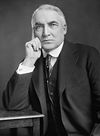Knox–Porter Resolution
 | |
| Other short titles | World War I Peace Resolution |
|---|---|
| Nicknames | Public Resolution 8 |
| Enacted by | the 67th United States Congress |
| Effective | July 2, 1921 |
| Citations | |
| Public law | 67-8 |
| Statutes at Large | 42 Stat. 105 |
| Legislative history | |
| |
The Knox–Porter Resolution (42 Stat. 105) was a joint resolution of the United States Congress signed by President Warren G. Harding on July 2, 1921, officially ending United States involvement in World War I. The documents were signed on the estate of Joseph Sherman Frelinghuysen, Sr. in Raritan, New Jersey.[1][2]
History
[edit]
On November 19, 1919, and again on March 19, 1920, the United States Senate voted against ratifying the Treaty of Versailles, forestalling American participation in the League of Nations. In a speech on April 12, 1921, before a special congressional session, President Harding reconfirmed American opposition to the League of Nations, calling on Congress to pass a peace resolution independent of the League. Senator Philander C. Knox of Pennsylvania introduced a resolution the following day, and it passed the Senate in late April.[3]
The United States House of Representatives had its own slightly different resolution introduced by Representative Stephen G. Porter, Chairman of the Committee on Foreign Affairs. Passage of the House resolution was delayed in deference to negotiations between the Allies and Germany over a reparations settlement. In late June the House and Senate reconciled their differences, and the Knox–Porter joint resolution passed Congress on July 1.
The next day, Harding signed the resolution at the Frelinghuysen estate in Raritan, New Jersey.[3] Harding and Senator Frehlinghuysen were playing golf at the Raritan Valley Country Club across the street when word arrived that a courier was on his way from the Raritan train station, having traveled from Washington with the signing copy of the resolution. Harding walked back to the estate and signed the document, and then returned to complete his round of golf. The Frelinghuysen estate was destroyed by fire in the 1950s, and the site is now occupied by a shopping center and parking lot, with a small plaque marking the place where the home once stood.[4][5]
The article in the next day's New York Times concerning the signing started with the words, "War with Germany ended as it began, by Congressional declaration and Executive signature on American soil."[6]
See also
[edit]- Treaty of Versailles
- 1921 U.S.–German Peace Treaty
- 1921 U.S.–Austrian Peace Treaty
- 1921 U.S.–Hungarian Peace Treaty
References
[edit]- ^ "Historic Sites". Somerset County Business Partnership. Archived from the original on 2008-03-29. Retrieved 2008-07-02.
In 1921, President Warren G. Harding, visiting the estate of his friend, Sen. Joseph S. Frelinghuysen, in Raritan, finished his golf game, returned to the mansion, and signed the Knox-Porter Resolution, officially ending World War I.
- ^ "Knox-Porter Resolution". Encyclopædia Britannica.
The Knox-Porter Resolution, ending the state of war between the United States and the Central Powers (Germany and Austria-Hungary), was signed (July 2, 1921) by President Warren G. Harding at the...
- ^ a b Wimer, Kurt; Wimer, Sarah (1967). "The Harding Administration, the League of Nations, and the Separate Peace Treaty". The Review of Politics. 29 (1): 13–24. doi:10.1017/S0034670500023706. JSTOR 1405810. S2CID 145794771..
- ^ "Glimpse of History: The official end to WWI for the U.S." 8 July 2016.
- ^ "Want fries with that treaty? World War I ends in Somerville".
- ^ Staff (July 3, 1921). "HARDING ENDS WAR; SIGNS PEACE DECREE AT SENATOR'S HOME. Thirty Persons Witness Momentous Act in Frelinghuysen Living Room at Raritan". The New York Times.
External links
[edit]- "Peace with Germany ~ Report No. 2". Internet Archive. Washington, D.C.: U.S. Library of Congress. April 25, 1921.
- "Terminating State of War with Germany and Austria-Hungary ~ Report No. 148". Internet Archive. Washington, D.C.: U.S. Library of Congress. June 7, 1921.
- "The Knox-Porter Resolution". History, Art & Archives ~ Office of the Historian. U.S. House of Representatives. June 30, 1921.
- "Treaty of Peace with Germany". Internet Archive. Washington, D.C.: U.S. Government Printing Office. September 21, 1921.

